Jane Goodall on Helping People to Help Nature
Air Date: Week of March 17, 2023
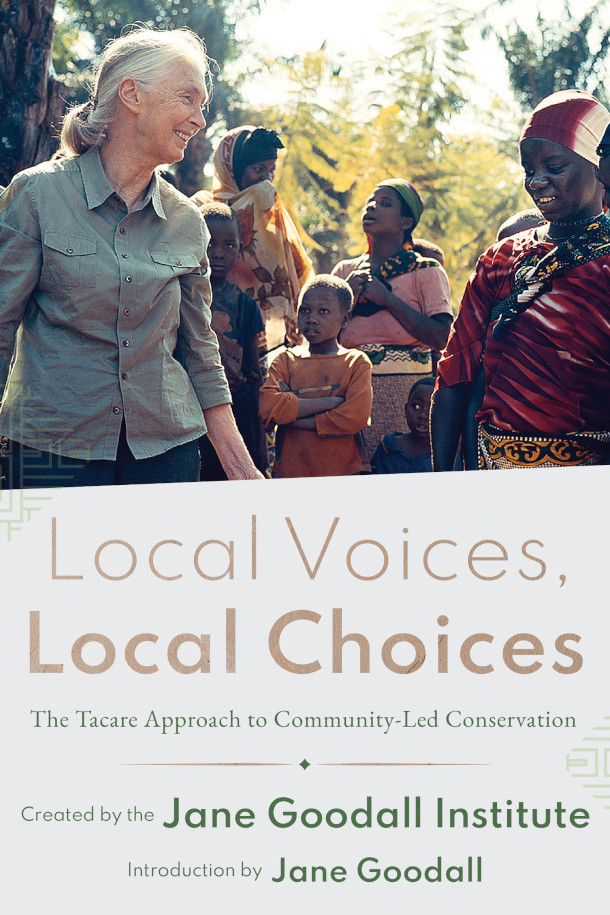
Local Voices, Local Choices: The Tacare Approach to Community-Led Conservation is the new book from the Jane Goodall Institute, with an introduction by Dr. Jane Goodall. (Photo: courtesy of the Jane Goodall Institute)
Jane Goodall is on a mission to protect habitat worldwide by empowering local communities to develop sustainably. She joins Host Steve Curwood for an in-depth conversation about this holistic approach to conservation and how it all started when she was just ten years old and dreamed of studying wild animals in Africa.
Transcript
CURWOOD: It’s Living on Earth, I’m Steve Curwood.
Jane Goodall is most famous for her groundbreaking work with chimpanzees in Tanzania. But she’s also a conservation activist and in 1977 co-founded the Jane Goodall Institute with a mission to protect habitat worldwide by empowering local communities to develop sustainably. A new book from the Jane Goodall Institute chronicles the stories behind its holistic approach to solving conservation challenges. The book title is “Local Voices Local Choices: The Tacare Approach to Community-Led Conservation” and joining me now to discuss it is Jane Goodall. Welcome back to Living on Earth!
GOODALL: Thank you.
CURWOOD: So in a nutshell, what is the Tacare approach to conservation? And how did it come about?
GOODALL: Well, in 1986, there were a total of six different chimpanzee study sites across Africa. When I began, it was just me. And so with the head of the Chicago Academy of Sciences, we decided it would be really good to bring the scientists from each of these sites together for a four day conference. The main purpose was to see whether chimp behavior differed in relationship to different environments, and if so, how, and was there something like culture, which I maintained, and which turns out to be true. But also we had a session on conservation and it was absolutely shocking because it was clear that right across Africa, chimpanzee numbers were decreasing, and forests were being destroyed. So I went to that conference as a scientist, I left as an activist. And I knew I had to do something, I hadn't a clue what to do, but got some money together, and visited these different sites. But even as I was learning about the problems faced by the chimps, I was learning about the plight of so many African people living in and around chimpanzee habitat, the crippling poverty, the lack of health and education facilities, the degradation of the land, as the human population grew and moved into chimpanzee habitat. And it came to a head when I flew over the tiny Gombe National Park, which had been part of a forest belt right across Africa. And when I looked down in the late 1980s, it was just a little island of forest surrounded by bare hills, more people than the land could support too poor to buy food elsewhere, cutting down trees to make money from timber, or charcoal, or to make more land to grow food for their growing families. And that's when it hit me. If we don't help these people find ways of making a living without destroying the environment, we can't save chimps, forests or anything else. And that was how Tacare began. And then, you know, as the villagers came to trust us, then we could introduce more than just growing more food and better health and education. We could introduce water management programs, scholarships, to give girls a chance to secondary education, microcredit, so that people could start their own small, environmentally sustainable businesses, and family planning.
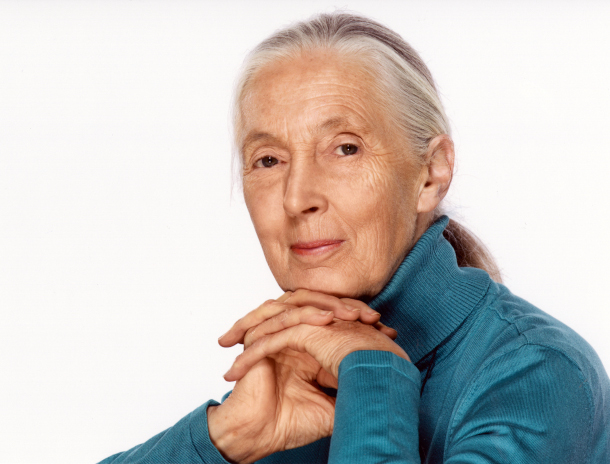
Dr. Jane Goodall has been working in the field of conservation for over 60 years. (Photo: Andrew Zuckerman, courtesy of the Jane Goodall Institute)
CURWOOD: So in these 60 plus years, what have you heard from local people near Gombe and Lake Tanganyika about how they feel about their forest and taking care of it.
GOODALL: As we work more and more closely with the local people, and they've learned to record the health of their forests, they really have understood the importance of the forest in their lives, that it helps to regulate temperature, that it provides shade, that it keeps moisture in the ground, regulates rainfall to some extent. And we introduced shade grown coffee that's put in coffee under the trees of the forest. So that really helps biodiversity and provides really good quality coffee. So it has won many prizes on the main coffee market of Tanzania. Five years running. Yeah.
CURWOOD: What's the brand of it by the way?
GOODALL: Well, it's in different countries, it's sold under different names. Gombe Reserve is the typical name in the US.
CURWOOD: So near Gombe, these communities are very remote and fairly traditional societies. How does your approach, how does the Tacare approach help them retain their traditions and cultural identity while allowing them to reap some of the benefits of modern society?
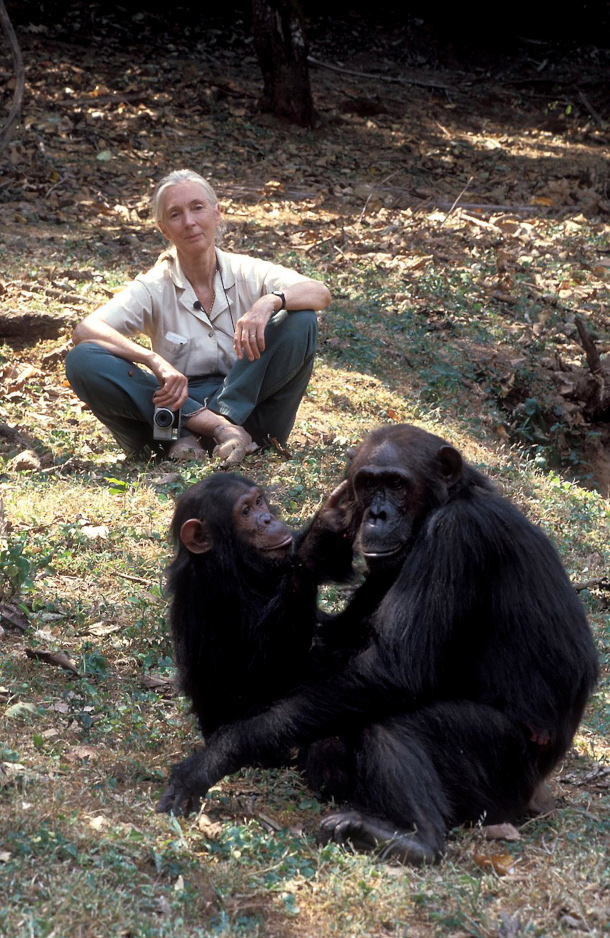
The Tacare Approach was first developed to help the people living near Gombe National Park in Tanzania, where Dr. Goodall began studying chimpanzees in 1960, to more sustainably manage their land, reducing deforestation and environmental degradation. (Photo: Kristin J. Mosher, courtesy of the Jane Goodall Institute)
GOODALL: Well, because we respect their traditions, and because, for example, we've managed to persuade the traditional healers, they used to be witch doctors, it used to be you only passed your knowledge from father to son, I don't think ever to a daughter. And so traditions were in danger of dying out. So we managed to persuade them to get together and they agreed to share their knowledge for the benefit of all the local people. And we started trying to grow some of the medicinal herbs. Interestingly, chimps and humans use very much the same plants to cure particular diseases. Who taught who? We don't know.
CURWOOD: What's up common plant for healing that both chimps and humans use there?
GOODALL: Well Aspilia is a certain leaf that they use for tummy upsets, things like that.
CURWOOD: We have a lot to learn from nature.
GOODALL: Yes.
CURWOOD: So, these days, you now have this program for young people you call Roots and Shoots. Tell us about that, I mean, you know, we're not exactly the youngest people in the world, Jane Goodall and myself. So the next generation is going to have to do a whole bunch of things. How does the roots and shoots youth program help develop leaders for the Tacare initiative to go forward?
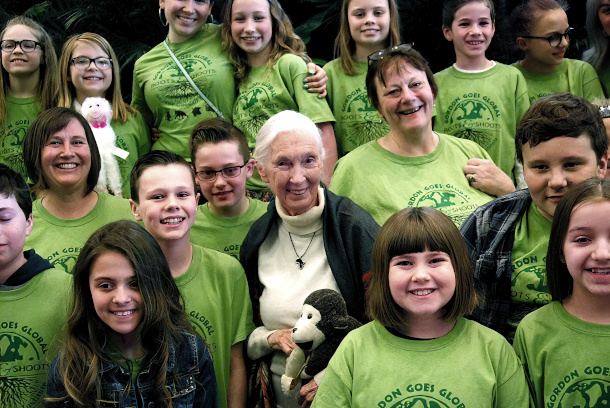
Roots and Shoots is the Jane Goodall Institute’s youth conservation program, with chapters in over 60 countries. (Photo: Mary Paris, courtesy of the Jane Goodall Institute)
GOODALL: Well, it began in 1991. All the time, you know, way back in the late 1980s, when I was already traveling around the world, giving lectures, raising awareness, and trying to raise funds as well, of course, I was meeting young people, high school, university, who already were losing hope. And they were either depressed, angry, or mostly just apathetic. And they told me when I asked, and this is all around the world really, "well, you've compromised our future, there's nothing we can do about it." Well, we have compromised their future, in fact we've been stealing it, we still are. But it's not true, there is something they can do about it, that there's a window of time, if we get together, we can start to heal some of the scars we've inflicted on poor old planet Earth, slow down climate change, slow down loss of biodiversity, these two existential threats that we face. So the young people, they form groups, and in that group, they discuss what they care about in their environment. Some of them care about people, poverty, homelessness, some of them care about animals, protection in the wild, conditions in captivity, some of them care about the environment, you know, looking after, protecting forests, growing organic food, having butterfly gardens. And so then they discuss what they can do, roll up their sleeves, get out there and do it. And what began with 12 high school students in Tanzania, is now in 68 countries around the world, members from kindergarten through university, even adults now forming groups, and they are changing the world. I talked about the bare hills, around Gombe back in the late 80s. Those bare hills aren't there anymore, the trees are coming back from seeds left in the ground, or from big tree planting operations conducted by Roots and Shoots for the main part. And with the trees coming back, so biodiversity comes back. And the one thing that they seem to keep with them, they have this respect, respect and compassion, respect for each other and the animals and the environment. And they're caring. So we're producing, yes, we are producing leaders of the next generation. But even more important, I think, we're producing caring and compassionate citizens, because not everybody is going to be a leader.
CURWOOD: So, I recall the story of a young Jane Goodall who went to this part of Tanzania, and was, you know, they acted like they thought you were crazy. To what extent do people who do this work have to be rebels do they have to say, no, no, no, no, no, we can't do it the old way, we have to do it a better new way?
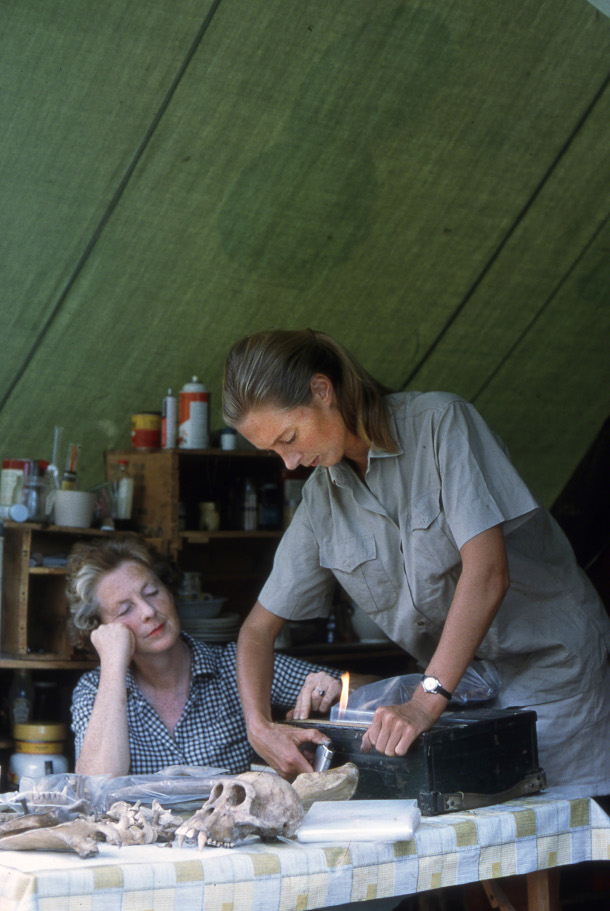
Dr. Goodall first traveled to Gombe National Park with her mother, Margaret, who set up a medical clinic for the local communities. (Photo: Hugo Van Lawick, courtesy of the Jane Goodall Institute)
GOODALL: Well, I was 10 years old, when I met this opposition to my dream of going to Africa, living with wild animals and writing books about them. Jane, dream about something you can achieve, how will you get to Africa, you don't have money, Africa's far away, it's dangerous, it's the dark continent full of dangerous animals and people. And I was just a girl. And it was my mother who said, Jane, if you really want to do this, you're going to have to work really hard, take advantage of every opportunity and, if you don't give up, hopefully, you'll find a way. So my mother supported me. And my family actually, it was everybody else who didn't. And then once I got there, I met Louis Leakey and he gave me this amazing opportunity to live with not just any animal, but the one closest to us, the chimpanzee. Then, you know, there was money only for six months. I mean, who was going to give money? Young girl, hadn't been to college, straight out from England. And I was really afraid that I wouldn't find out anything really useful and my dream would end because the chimps ran away from me to start with and then this one chimpanzee, male, David Greybeard, gentle disposition, very handsome, probably about 25 years old, for some reason, he began to lose his fear of me before the others. It was he whom I saw using and making tools to fish for termites, which was supposed to be unique to us, we were the only tool-using, tool-making animal. And it was that that brought in the National Geographic Society. And then I could stay on. And the local people, when I first arrived, they thought, "oh, Jane will last, maybe one or two weeks, and then she'll go," but of course, they were wrong. I didn't feel I was rebelling. But I think what's needed for people doing something like this is passion, you need to be absolutely passionate about it, and then determined that you're going to succeed and know that you're on the right path.
CURWOOD: Jane Goodall, as we're speaking to you in March of 2023. This month is also Women's History Month. So let me ask you, how has the world of science changed for women since you started this work? And what are the challenges that you think women still face?
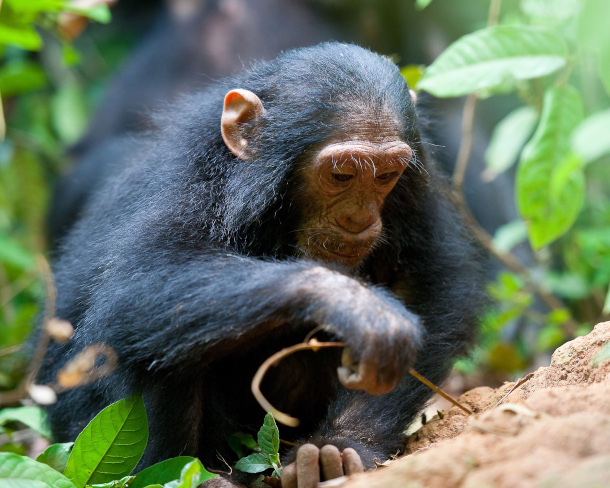
Dr. Jane Goodall was the first to observe chimpanzees making and using tools to fish for termites. (Photo: Nick Riley, courtesy of the Jane Goodall Institute)
GOODALL: Science has changed for women hugely since I was young, because, you know, when I was dreaming of Africa and animals, I didn't dream of being a scientist, because girls simply didn't do that sort of thing. And gradually, it's changed. And gradually, more and more women are coming into science. I think one problem at one time was that science, it was very cold. The early ethologists, those studying animal behavior, were extremely reductionist. For example, I was told you shouldn't have named the chimpanzees, they should have had numbers, that's scientific, you cannot talk about their personalities, their minds, or their emotions, those are unique to us. You cannot be showing empathy for your subjects. To be a good scientist, you must be objective, coldly objective. And of course, anybody who's shared their life with a dog, a cat, a rabbit, a horse, I don't care what animal, knows that that's wrong. And I'm sure those early scientists didn't really believe it, but they couldn't prove it. And it was the chimpanzees that really broke that model. Because once the film shot by my husband, Hugo van Lawick, began going around the world, then you could see with your own eyes, of course chimpanzees have many of the emotions we have, and the postures and the gestures that we have. And so gradually, now, we're studying the emotions and the incredible intelligence of, for example, the octopus, you know, "My Octopus Teacher." Octopuses are amazingly intelligent. Crows. Crows can solve some problems faster than an eight year old human child, unless they're a genius child. So I think that women were put off by this coldness, to some extent, but now it's got warmer. And I think that's encouraging a lot of girls to go into science. And I have to say it that hundreds have said to me, "Jane, it was after I heard your lecture or saw your film, that I decided this was what I was going to do. Because you did it, I can do it too." Whatever it is, just if they had a dream, not to listen to people who said you can't do that. But to follow it, just as I followed mine.
CURWOOD: The new book from the Jane Goodall Institute with an introduction by Dr. Jane Goodall herself, "Local Voices, Local Choices: The Tacare Approach to Community-Led Conservation" is a guidebook for effective and enduring sustainability and an inspiration to anyone trying to make a difference in this world. Jane Goodall, thank you so much for joining us again. We hope to see you again soon in another couple of years.
GOODALL: Thanks so much for inviting me.
CURWOOD: And it's a little early but, happy birthday.
GOODALL: Thank you. Well, next year I'll be 90. How about that?
CURWOOD: There you go. Well, the world needs you so let's keep you around.
GOODALL: Thanks.
Links
Living on Earth wants to hear from you!
Living on Earth
62 Calef Highway, Suite 212
Lee, NH 03861
Telephone: 617-287-4121
E-mail: comments@loe.org
Newsletter [Click here]
Donate to Living on Earth!
Living on Earth is an independent media program and relies entirely on contributions from listeners and institutions supporting public service. Please donate now to preserve an independent environmental voice.
NewsletterLiving on Earth offers a weekly delivery of the show's rundown to your mailbox. Sign up for our newsletter today!
 Sailors For The Sea: Be the change you want to sea.
Sailors For The Sea: Be the change you want to sea.
 The Grantham Foundation for the Protection of the Environment: Committed to protecting and improving the health of the global environment.
The Grantham Foundation for the Protection of the Environment: Committed to protecting and improving the health of the global environment.
 Contribute to Living on Earth and receive, as our gift to you, an archival print of one of Mark Seth Lender's extraordinary wildlife photographs. Follow the link to see Mark's current collection of photographs.
Contribute to Living on Earth and receive, as our gift to you, an archival print of one of Mark Seth Lender's extraordinary wildlife photographs. Follow the link to see Mark's current collection of photographs.
 Buy a signed copy of Mark Seth Lender's book Smeagull the Seagull & support Living on Earth
Buy a signed copy of Mark Seth Lender's book Smeagull the Seagull & support Living on Earth

